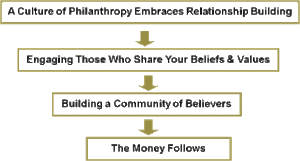In today’s nonprofit arena, organizations that achieve the greatest fundraising success cultivate a collaborative culture of philanthropy among all staff and volunteers. Such a culture is reflected in both top-down and bottom-up policies and processes, and all those in the organization, from Board to staff, view their roles and responsibilities as critical to fundraising success. All stakeholders understand the role of contributed income in realizing the organization’s mission, vision and goals; they recognize that development work is central to institutional decision-making and must be adequately resourced.
A recent study, a joint project of CompassPoint and the Evelyn and Walter Haas, Jr. Fund, reminds the fundraising world of the challenges that can plague development programs if a culture of philanthropy does not permeate an organization.
The study had a compelling definition of the culture of philanthropy that development staff can share with their executive directors, Board members and program staff to help them better understand the need for collaboration:
– UnderDeveloped: A National Study of Challenges Facing Nonprofit Fundraising

Schultz & Williams understands that—depending on an organization’s current ethos—our clients’ development staff may face varying challenges in creating and fostering a true culture of philanthropy. These challenges can include budgetary restraints, an unclear case for support, lack of professional skills within the development department, and a senior staff and volunteers who are uncomfortable with their fundraising roles. We believe that the development director and staff can lead the way toward a cultural transformation.
S&W recommends that development staff invite, as appropriate, senior staff, Board members, development committee members and key program staff to working meetings that are designed to create a forum for dialogue about development topics. These could include:
- The function of philanthropy
- Why do donors support your organization?
- How does contributed income serve the organization—both its perceived and actual functions?
- The donor experience
- What is the current donor lifecycle?
- What do our donors want from our organization?
- What is the ideal donor experience?
- Insiders’ roles in philanthropy
- Executive director
- Board
- Program staff
- Finance/CFO
- Communicating about philanthropy
It takes time to fostering cultural change, but dialogue among staff and Board is critical. By engaging your Board and staff in discussions about advancing contributed income, evolving relationships with donors and creating interdepartmental activities to support development, your organization will be able to create a culture of philanthropy in which all stakeholders feel accountable




